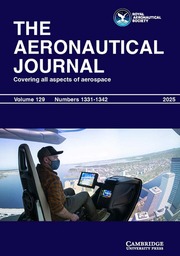Crossref Citations
This article has been cited by the following publications. This list is generated based on data provided by
Crossref.
Afagh, F. F.
Nitzsche, F.
and
Morozova, N.
2004.
Dynamic modelling and stability of hingeless helicopter blades with a smart spring.
The Aeronautical Journal ,
Vol. 108,
Issue. 1085,
p.
369.
Chen, Yong
Wickramasinghe, Viresh
and
Zimcik, David
2005.
Experimental evaluation of the Smart Spring for helicopter vibration suppression through blade root impedance control.
Smart Materials and Structures,
Vol. 14,
Issue. 5,
p.
1066.
Chen, Yong
Wickramasinghe, Viresh
and
Zimcik, David
2005.
Smart Spring Impedance Control Algorithm for Helicopter Blade Harmonic Vibration Suppression.
Journal of Vibration and Control,
Vol. 11,
Issue. 4,
p.
543.
Coppotelli, Giuliano
Marzocca, Pier
Ulker, Fatma
Nitzsche, Fred
and
Campbell, Julia
2006.
SHARCS Project: Modal Parameters Identification of Smart Spring/Helicopter Blade System.
Lang, Sidney B.
2006.
Guide to the Literature of Piezoelectricity and Pyroelectricity. 26.
Ferroelectrics,
Vol. 332,
Issue. 1,
p.
227.
Wickramasinghe, Viresh
Yong Chen
and
Zimcik, David
2008.
Experimental Evaluation of the Smart Spring Impedance Control Approach for Adaptive Vibration Suppression.
Journal of Intelligent Material Systems and Structures,
Vol. 19,
Issue. 2,
p.
171.
Coppotelli, G.
Marzocca, P.
Ulker, F. D.
Campbell, J.
and
Nitzsche, F.
2008.
Experimental Investigation on Modal Signature of Smart Spring/Helicopter Blade System.
Journal of Aircraft,
Vol. 45,
Issue. 4,
p.
1373.
Grewal, Anant
Wickramasinghe, Viresh
Chen, Yong
and
Zimcik, David
2010.
Modulation Control of Bi-State Adaptive Impedance Device for Active Vibration Suppression.
Orlando, Diego
and
Goncalves, Paulo B.
2013.
Hybrid nonlinear control of a tall tower with a pendulum absorber.
Structural Engineering and Mechanics,
Vol. 46,
Issue. 2,
p.
153.
Nitzsche, Fred
Feszty, Daniel
Grappasonni, Chiara
and
Coppotelli, Giuliano
2013.
Whirl-tower Open-loop Experiments and Simulations with an Adaptive Pitch Link Device for Helicopter Rotor Vibration Control.
Duerr, K.
Tesfamariam, S.
Wickramasinghe, V.
and
Grewal, A.
2013.
Variable stiffness smart structure systems to mitigate seismic induced building damages.
Earthquake Engineering & Structural Dynamics,
Vol. 42,
Issue. 2,
p.
221.
Gaul, L.
and
Becker, J.
2014.
Reduction of Structural Vibrations by Passive and Semiactively Controlled Friction Dampers.
Shock and Vibration,
Vol. 2014,
Issue. ,
p.
1.
Arras, Melissa
Coppotelli, Giuliano
Nitzsche, Fred
and
Feszty, Daniel
2015.
Identification of the Smart Spring properties from FRFs measurements.
Han, D.
2016.
Flap-wise loads reduction of rotor blades by embedded flap-wise absorbers.
The Aeronautical Journal,
Vol. 120,
Issue. 1230,
p.
1215.
Marqués, Pascual
2017.
Advanced UAV Aerodynamics, Flight Stability and Control.
p.
399.
Clementino, Marcel A.
Nitzsche, Fred
and
De Marqui, Carlos
2017.
Experimental Verification of a Semi-Active Piezoelectric Pitch Link for Helicopter Vibration Attenuation.
Rafiee, M.
Nitzsche, F.
and
Labrosse, M.
2017.
Dynamics, vibration and control of rotating composite beams and blades: A critical review.
Thin-Walled Structures,
Vol. 119,
Issue. ,
p.
795.
Wu, Y.G.
Li, L.
Fan, Y.
Ma, H.Y.
Wang, W.J.
Christen, J.-L.
and
Ichchou, M.
2019.
Design of semi-active dry friction dampers for steady-state vibration: sensitivity analysis and experimental studies.
Journal of Sound and Vibration,
Vol. 459,
Issue. ,
p.
114850.
Shivashankar, P
and
Gopalakrishnan, S
2020.
Design, modeling and testing of d33-mode surface-bondable multilayer piezoelectric actuator.
Smart Materials and Structures,
Vol. 29,
Issue. 4,
p.
045016.
Shivashankar, P
and
Gopalakrishnan, S
2020.
Review on the use of piezoelectric materials for active vibration, noise, and flow control.
Smart Materials and Structures,
Vol. 29,
Issue. 5,
p.
053001.

